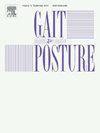Does the Hawthorne effect influence gait assessment in stroke patients?
IF 2.2
3区 医学
Q3 NEUROSCIENCES
引用次数: 0
Abstract
Background
Gait assessments are essential in post-stroke rehabilitation to quantify impairments, identify underlying causes, and guide treatment. Gait assessments may, however, be influenced by the “Hawthorne effect”, the phenomenon of behavioral change in response to observation. This has not been studied properly in people post-stroke. This study examined the Hawthorne effect during post-stroke gait assessment, distinguishing between observation only and observation plus awareness of gait measurement.
Methods
Twenty adults post-stroke walked during three gait conditions: unobserved walking, walking while being observed, and walking with observation plus awareness of gait measurement. Spatiotemporal gait parameters were collected using inertial measurement units. Primary outcome was gait speed. Secondary outcomes were stride length, stride time, stride time variance and stance time symmetry.
Results
A repeated measures ANOVA revealed significant differences in gait speed, stride length, and stride time. Post-hoc tests showed that observation plus awareness of measurement led to higher gait speed (p = 0.004, diff=0.05 m/s) and stride length (p = 0.010, diff=0.03 m), and shorter stride time (p = 0.020, diff=-0.03 s) compared to unobserved walking. Gait speed was also higher (p = 0.004, diff=0.03 m/s) and stride time was also shorter (p = 0.040, diff=-0.02 s) in the observed plus measured condition compared to the observed condition. No significant differences were found between the observed and unobserved condition, or for stride time variance and stance time symmetry.
Conclusion
While observation plus awareness of gait measurement significantly influenced gait parameters post-stroke, changes were small and did not exceed the minimal clinical important differences. Thus, the Hawthorne effect is unlikely to influence clinical decision-making during post-stroke gait assessment.
霍桑效应是否影响脑卒中患者的步态评估?
步态评估在卒中后康复中对量化损伤、确定潜在原因和指导治疗至关重要。然而,步态评估可能受到“霍桑效应”(Hawthorne effect)的影响,即对观察做出反应的行为改变现象。这在中风后的人群中还没有得到适当的研究。本研究考察了脑卒中后步态评估中的霍桑效应,区分了仅观察和观察加意识的步态测量。方法20例成人脑卒中后步行,分为三种步态:不被观察的步行、被观察的步行和观察加步态测量意识的步行。采用惯性测量单元采集步态时空参数。主要终点是步态速度。次要指标为步幅、步幅时间、步幅时间方差和站姿时间对称性。结果重复测量方差分析显示,两组患者在步速、步长和步幅时间上存在显著差异。事后测试显示,观察测量+意识导致更高的步态速度(p = 0.004,差异= 0.05 m / s)和步幅(p = 0.010,差异= 0.03 m),和跨步时间短(p = 0.020,差异= -0.03 s)而未被注意的行走。与观察组相比,观察加测量组的步态速度更快(p = 0.004,diff=0.03 m/s),步幅时间也更短(p = 0.040,diff=-0.02 s)。在观察和未观察条件之间,或在步幅时间方差和姿态时间对称性之间,没有发现显著差异。结论观察加步态测量意识对卒中后步态参数有显著影响,但变化不大,不超过最小的临床重要差异。因此,霍桑效应不太可能影响中风后步态评估的临床决策。
本文章由计算机程序翻译,如有差异,请以英文原文为准。
求助全文
约1分钟内获得全文
求助全文
来源期刊

Gait & posture
医学-神经科学
CiteScore
4.70
自引率
12.50%
发文量
616
审稿时长
6 months
期刊介绍:
Gait & Posture is a vehicle for the publication of up-to-date basic and clinical research on all aspects of locomotion and balance.
The topics covered include: Techniques for the measurement of gait and posture, and the standardization of results presentation; Studies of normal and pathological gait; Treatment of gait and postural abnormalities; Biomechanical and theoretical approaches to gait and posture; Mathematical models of joint and muscle mechanics; Neurological and musculoskeletal function in gait and posture; The evolution of upright posture and bipedal locomotion; Adaptations of carrying loads, walking on uneven surfaces, climbing stairs etc; spinal biomechanics only if they are directly related to gait and/or posture and are of general interest to our readers; The effect of aging and development on gait and posture; Psychological and cultural aspects of gait; Patient education.
 求助内容:
求助内容: 应助结果提醒方式:
应助结果提醒方式:


